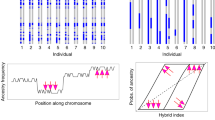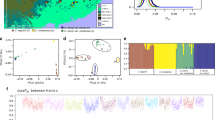Abstract
Botanists have long believed that hybrid speciation is important, especially after chromosomal doubling (allopolyploidy). Until recently, hybridization was not thought to play a very constructive part in animal evolution. Now, new genetic evidence suggests that hybrid speciation, even without polyploidy, is more common in plants and also animals than we thought.
This is a preview of subscription content, access via your institution
Access options
Subscribe to this journal
Receive 51 print issues and online access
$199.00 per year
only $3.90 per issue
Buy this article
- Purchase on Springer Link
- Instant access to full article PDF
Prices may be subject to local taxes which are calculated during checkout

Similar content being viewed by others
References
Lotsy, J. P. Evolution by Means of Hybridization (Martinus Nijhoff, The Hague, 1916)
Mayr, E. Animal Species and Evolution (Harvard Univ. Press, Cambridge, Massachusetts, 1963)
Stebbins, G. L. Processes of Organic Evolution (Prentice-Hall, Englewood Cliffs, New Jersey, 1971)
Grant, V. Plant Speciation (Columbia Univ. Press, New York, 1981)
Barton, N. H. The role of hybridization in evolution. Mol. Ecol. 10, 551–568 (2001). Medline
Coyne, J. A. & Orr, H. A. Speciation (Sinauer Associates, Sunderland, Massachusetts, 2004)
Anderson, E. & Stebbins, G. L. Hybridization as an evolutionary stimulus. Evolution 8, 378–388 (1954)
Arnold, M. L. Natural Hybridization and Evolution (Oxford Univ. Press, Oxford, 1997)
Seehausen, O. Hybridization and adaptive radiation. Trends Ecol. Evol. 19, 198–207 (2004).
Dowling, T. E. & Secor, C. L. The role of hybridization and introgression in the diversification of animals. Annu. Rev. Ecol. Syst. 28, 593–620 (1997)
Bullini, L. Origin and evolution of animal hybrid species. Trends Ecol. Evol. 9, 422–426 (1994)
Grant, P. R., Grant, B. R. & Petren, K. Hybridization in the recent past. Am. Nat. 166, 56–57 (2005).
Mallet, J. A species definition for the modern synthesis. Trends Ecol. Evol. 10, 294–299 (1995)
Butlin, R. Speciation by reinforcement. Trends Ecol. Evol. 2, 8–12 (1987)
Ortíz-Barrientos, D., Counterman, B. A. & Noor, M. A. F. The genetics of speciation by reinforcement. PLoS Biol. 2, e416 (2004)
Tunner, H. G. & Nopp, H. Heterosis in the common European water frog. Naturwissenschaften 66, 268–269 (1979).
Fisher, R. A. The Genetical Theory of Natural Selection (Clarendon Press, Oxford, 1930)
Mallet, J. Hybridization as an invasion of the genome. Trends Ecol. Evol. 20, 229–237 (2005).
Husband, B. C. Constraints on polyploid evolution: a test of the minority cytotype exclusion principle. Proc. R. Soc. Lond. B 267, 217–223 (2000)
Wright, S. The roles of mutation, inbreeding, crossbreeding and selection in evolution. Proc. XI Int. Congr. Genet. Hague 1, 356–366 (1932)
Otto, S. P. & Whitton, J. Polyploid incidence and evolution. Annu. Rev. Genet. 34, 401–437 (2000).
Ramsey, J. & Schemske, D. W. Neopolyploidy in flowering plants. Annu. Rev. Ecol. Syst. 33, 589–639 (2002)
Astaurov, B. L. Experimental polyploidy in animals. Annu. Rev. Genet. 3, 99–126 (1969)
Muller, H. J. Why polyploidy is rarer in animals than in plants. Am. Nat. 59, 346–353 (1925)
Mable, B. K. ‘Why polyploidy is rarer in animals than in plants’: myths and mechanisms. Biol. J. Linn. Soc. 82, 453–466 (2004)
Soltis, D. E., Soltis, P. S. & Tate, J. A. Advances in the study of polyploidy since plant speciation. New Phytol. 161, 173–191 (2004)
Brochmann, C. et al. Polyploidy in arctic plants. Biol. J. Linn. Soc. 82, 521–536 (2004)
Abbott, R. J. & Lowe, A. J. Origins, establishment and evolution of new polyploid species: Senecio cambrensis and S. eboracensis in the British Isles. Biol. J. Linn. Soc. 82, 467–474 (2004)
Ainouche, M. L., Baumel, A. & Salmon, A. Spartina anglica C. E. Hubbard: a natural model system for analysing early evolutionary changes that affect allopolyploid genomes. Biol. J. Linn. Soc. 82, 475–484 (2004)
Buerkle, C. A., Morris, R. J., Asmussen, M. A. & Rieseberg, L. H. The likelihood of homoploid hybrid speciation. Heredity 84, 441–451 (2000).
Rieseberg, L. H. Hybrid origins of plant species. Annu. Rev. Ecol. Syst. 28, 359–389 (1997)
Rieseberg, L. H., Raymond, O., Rosenthal, D. M., Lai, Z. & Livingstone, K. Major ecological transitions in wild sunflowers facilitated by hybridization. Science 301, 1211–1216 (2003).
Gross, B. L. & Rieseberg, L. H. The ecological genetics of homoploid hybrid speciation. J. Hered. 96, 241–252 (2005).
Nolte, A. W., Freyhof, J., Stemshorn, K. C. & Tautz, D. An invasive lineage of sculpins, Cottus sp. (Pisces, Teleostei) in the Rhine with new habitat adaptations has originated from hybridization between old phylogeographic groups. Proc. R. Soc. Lond. B 272, 2379–2387 (2005)
DeMarais, B. D., Dowling, T. E., Douglas, M. E., Minckley, W. L. & Marsh, P. C. Origin of Gila seminuda (Teleostei: Cyprinidae) through introgressive hybridization: implications for evolution and conservation. Proc. Natl Acad. Sci. USA 89, 2747–2751 (1992).
Gompert, Z., Fordyce, J. A., Forister, M., Shapiro, A. M. & Nice, C. C. Homoploid hybrid speciation in an extreme habitat. Science 314, 1923–1925 (2006).
Schwarz, D., Matta, B. M., Shakir-Botteri, N. L. & McPheron, B. A. Host shift to an invasive plant triggers rapid animal hybrid speciation. Nature 436, 546–549 (2005).
Mavárez, J. et al. Speciation by hybridization in Heliconius butterflies. Nature 441, 868–871 (2006).
Meyer, A., Salzburger, W. & Schartl, M. Hybrid origin of a swordtail species (Teleostei: Xiphophorus clemenciae) driven by sexual selection. Mol. Ecol. 15, 721–730 (2006).
Labandeira, C. C. & Sepkoski, J. J. Insect diversity in the fossil record. Science 261, 310–315 (1993).
Patterson, N., Richter, D. J., Gnerre, S., Lander, E. S. & Reich, D. Genetic evidence for complex speciation of humans and chimpanzees. Nature 441, 1103–1108 (2006).
Evans, P. D., Mekel-Bobrov, N., Vallender, E. J., Hudson, R. R. & Lahn, B. T. Evidence that the adaptive allele of the brain size gene microcephalin introgressed into Homo sapiens from an archaic Homo lineage. Proc. Natl Acad. Sci. USA 103, 18178–18183 (2006).
Barton, N. H. How did the human species form? Curr. Biol. 16, R647–R650 (2006).
Seehausen, O., van Alphen, J. J. M. & Witte, F. Cichlid fish diversity threatened by eutrophication that curbs sexual selection. Science 277, 1808–1811 (1997)
Grant, B. R. & Grant, P. R. High survival of Darwin’s finch hybrids — effects of beak morphology and diets. Ecology 77, 500–509 (1996)
Acknowledgements
I thank C. Brochmann, K. Dasmahapatra, B. Husband, S. Knapp, M. Linares, J. Mavárez, A. Meyer, P. Nosil, S. Otto, C. Salazar and S. Turelli for discussions and comments. The work was supported, in part, by grants from NERC and the DEFRA Darwin Initiative programme.
Author information
Authors and Affiliations
Corresponding author
Ethics declarations
Competing interests
Reprints and permissions information is available at www.nature.com/reprints. The author declares no competing financial interests.
Rights and permissions
About this article
Cite this article
Mallet, J. Hybrid speciation. Nature 446, 279–283 (2007). https://doi.org/10.1038/nature05706
Issue Date:
DOI: https://doi.org/10.1038/nature05706
This article is cited by
-
Multiple contact zones and karyotypic evolution in a neotropical frog species complex
Scientific Reports (2024)
-
Intermediary floral traits between natural hybrid and its parents in the Xiquexique (Cactaceae)
Organisms Diversity & Evolution (2024)
-
Opportunities and challenges in studies of mammalian hybrid speciation
Science China Life Sciences (2024)
-
Hybridization barriers between the congeneric antarctic notothenioid fish Notothenia coriiceps and Notothenia rossii
Polar Biology (2024)
-
Physiology and transcriptomics reveal that hybridization improves the tolerance of poplar photosynthetic function to salt stress
Trees (2024)
Comments
By submitting a comment you agree to abide by our Terms and Community Guidelines. If you find something abusive or that does not comply with our terms or guidelines please flag it as inappropriate.



